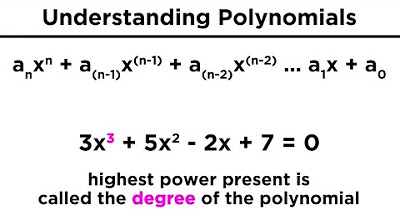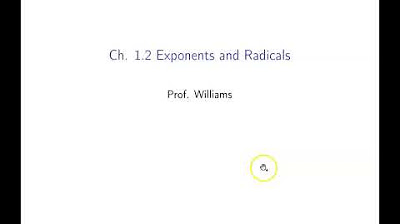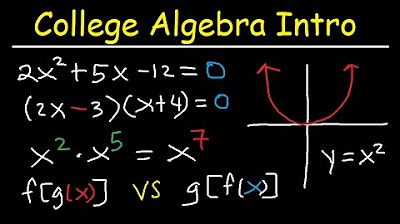Exponents Explained!
TLDRThis video teaches how to use exponents to simplify repetitive multiplication. Starting with basic examples, it shows how expressions like 'three times three times three times three' can be written as 'three to the fourth power.' It explains how exponents can simplify various expressions, such as monomials and polynomials, and demonstrates how to expand and evaluate these expressions. The video also covers the nuances of dealing with zero and negative exponents and provides practical examples of evaluating expressions with given variable values. This comprehensive guide helps viewers master the use of exponents in mathematics.
Takeaways
- 📚 Exponents are used to simplify repetitive multiplication in expressions.
- 🔢 The expression 'three four times' can be written as 'three to the fourth power' using exponents.
- 🌟 Anytime you have repeated multiplication, you can use exponents to simplify the expression.
- 📈 For example, 'five x variables multiplied together' can be written as 'x to the fifth power'.
- 🔄 The expression 'x plus 5 times x plus 5, times x plus five, three times' is equivalent to '(x + 5) raised to the third power'.
- 📝 A single term in an algebraic expression is called a monomial.
- 📉 To expand expressions with exponents, you multiply the base number by itself as many times as indicated by the exponent.
- 👉 Evaluating expressions with exponents involves multiplying the base number by itself the number of times indicated by the exponent.
- ❗ Understanding the difference between 'negative seven squared' with and without parentheses is crucial for correct evaluation.
- 🚫 Anything raised to the zero power equals one, including negative numbers.
- 🔢 Evaluating algebraic expressions involves substituting given values for variables and performing the indicated operations.
Q & A
What is the alternative way to express 'three times three times three times four'?
-The alternative way to express 'three times three times three times four' is to use exponents, specifically 'three to the fourth power' or 3^4.
What is the purpose of using exponents in mathematical expressions?
-Exponents are used to simplify repetitive multiplication in expressions, making them easier to read and work with.
How would you express five variables of 'x' multiplied together using exponents?
-You would express five variables of 'x' multiplied together as x^5, which is 'x to the fifth power'.
What is the expression equivalent to 'x plus 5 times x plus 5, times x plus five, three times'?
-The expression 'x plus 5 times x plus 5, times x plus five, three times' is equivalent to (x + 5)^3, which is '(x plus 5) raised to the third power'.
How can you simplify the expression '4 times x times x times y times y times y'?
-The expression '4 times x times x times y times y times y' can be simplified to 4x^2y^3, which is '4 times x squared times y cubed'.
What is a monomial and how is it represented in the expression '4x^2y^3'?
-A monomial is a single term algebraic expression. In '4x^2y^3', the monomial is represented by the term without any addition or subtraction operations.
How do you expand the expression '8x^4y^5'?
-To expand '8x^4y^5', you multiply 8 by x^4 (which is x * x * x * x) and by y^5 (which is y * y * y * y * y) to get the expanded form.
What is the result of evaluating '2 to the fourth power'?
-Evaluating '2 to the fourth power' (2^4) results in 2 * 2 * 2 * 2 which equals 16.
How does the negative sign affect the evaluation of 'negative seven squared' with and without parentheses?
-Without parentheses, as in '-7 squared', the negative sign is squared along with the 7, resulting in (-7)^2 = 49. With parentheses, as in '(-7) squared', only the 7 is squared, resulting in -1 * 7^2 = -49.
What is the rule for any number raised to the zero power?
-Any number raised to the zero power equals one, so a^0 = 1 for any non-zero number 'a'.
How do you evaluate the expression 'a squared plus b squared' when a is 3 and b is 4?
-To evaluate 'a squared plus b squared' with a = 3 and b = 4, you calculate 3^2 + 4^2 = 9 + 16 = 25.
What is the result of the expression '2x cubed minus y squared' when x is 2 and y is -3?
-With x = 2 and y = -3, the expression '2x cubed minus y squared' becomes 2 * 2^3 - (-3)^2 = 2 * 8 - 9 = 16 - 9 = 7.
How do you evaluate the expression '2x squared plus 3x minus 5' when x is 5?
-To evaluate '2x squared plus 3x minus 5' with x = 5, you calculate 2 * 5^2 + 3 * 5 - 5 = 2 * 25 + 15 - 5 = 50 + 15 - 5 = 60.
What is the final result of the expression '3 times 2y minus 5 squared' when y is 4?
-With y = 4, the expression '3 times 2y minus 5 squared' becomes 3 * (2 * 4 - 5)^2 = 3 * 3^2 = 3 * 9 = 27.
Outlines
📚 Introduction to Exponents and Monomials
This paragraph introduces the concept of exponents as a method to simplify repetitive multiplication in expressions. It explains that exponents can be used to represent a base number multiplied by itself a certain number of times, such as 3 to the fourth power. The paragraph provides examples of how to rewrite expanded expressions as monomials using exponents, including variables like x and y. It also demonstrates the process of simplifying expressions with exponents, and converting them back to their expanded forms. The examples given include powers of 4, x, y, and expressions involving variables and constants like 3, a, and b.
🔢 Evaluating Exponents and Understanding Zero Exponents
This paragraph delves into the process of evaluating expressions with exponents, starting with the basics of how to calculate powers of numbers like 2 to the fourth and 3 to the third. It emphasizes the difference between expressions with parentheses and without, highlighting how the negative sign is handled in each case. The paragraph also explains the rule that any number raised to the power of zero equals one, with examples to illustrate this concept. Additionally, it covers the evaluation of algebraic expressions with variables, such as a squared plus b squared, and demonstrates how to substitute values for variables to find the result.
📘 Advanced Evaluation of Algebraic Expressions
The final paragraph focuses on the evaluation of more complex algebraic expressions involving exponents and variables. It provides examples of expressions with multiple terms and variables, such as 2x cubed minus y squared, and demonstrates the process of substituting specific values for the variables to find the numerical result. The paragraph also includes an example of evaluating an expression with a variable raised to a power and a subtraction term, showing the step-by-step process of simplifying the expression and calculating the final answer.
Mindmap
Keywords
💡Exponents
💡Monomial
💡Expanding Expressions
💡Evaluating Expressions
💡Zero Exponent
💡Algebraic Expressions
💡Substitution
💡Binomial
💡Algebraic Rules
💡Algebraic Simplification
💡Algebraic Equations
Highlights
Introduction to exponents as a way to simplify repetitive multiplication.
Exponentiation allows expressing 'three times three times three times four' as '3 to the fourth power'.
Any repetitive multiplication can be represented using exponents.
Example given: 'five x variables multiplied together' can be written as 'x to the fifth power'.
Demonstration of simplifying 'x plus 5 times x plus 5, times x plus five' to '(x + 5)^3'.
Instructions to rewrite four given expressions using exponents.
Explanation of a monomial and how to simplify expressions to form one.
Conversion of single 4 to '4 to the first power' or simply '4'.
Multiplication of two x variables is simplified to 'x squared'.
Three y variables can be written as 'y cubed'.
Second example simplifies to 'a squared b cubed'.
Third example involves negative five raised to the third power, resulting in negative 125.
Fourth example shows 'seven y plus two squared' as a simplified monomial.
Guidance on expanding monomials like '8' and 'x to the fourth' into their expanded form.
How to expand 'nine c to the fourth d to the third' into its full form.
Evaluation of expressions like 'two to the fourth power' to demonstrate exponent usage.
Explanation of the difference between 'negative seven squared' with and without parentheses.
Clarification that any number to the zero power equals one.
Demonstration of evaluating expressions with variables, such as 'a squared plus b squared'.
Example of evaluating '2x cubed minus y squared' with specific values for x and y.
Evaluation of 'two x squared plus three x minus five' with x as five.
Final example of evaluating '3 times 2y minus 5 squared' with y as four.
Transcripts
Browse More Related Video

The Power Rule For Derivatives

Introduction to Polynomials

How To Evaluate Expressions With Variables Using Order of Operations

Simplifying Trigonometric Expressions Using Power Reducing Formulas

Ch. 1.2 Exponents and Radicals

College Algebra Introduction Review - Basic Overview, Study Guide, Examples & Practice Problems
5.0 / 5 (0 votes)
Thanks for rating: